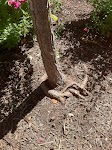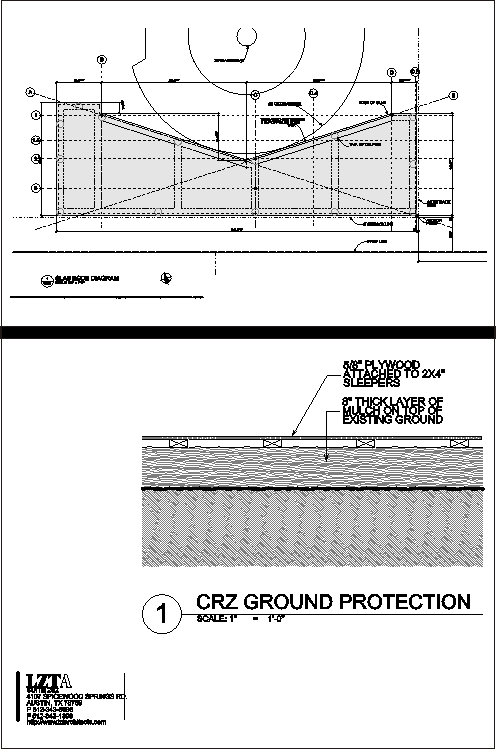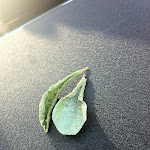 Most planted trees in the Austin area are container grown trees. Most container grown trees develop girdling roots. If you’ve planted a tree, there is a good chance this is going to be an issue for your tree. Girdling roots are a serious problem. The end result is the tree literally choking itself. Tree death is the typical result from severely girdling roots. Even if your tree is lucky enough to survive, overall health and vigor will be poor. Behind construction and weed-n-feed damage, this is probably the third most prevalent and serious tree issue I run into out in the field (especially for transplanted trees). The picture to the left shows a typical looking girdling root. Keep in mind these aren’t always visible from surface level. Sometimes you have to dig down to find them.
Most planted trees in the Austin area are container grown trees. Most container grown trees develop girdling roots. If you’ve planted a tree, there is a good chance this is going to be an issue for your tree. Girdling roots are a serious problem. The end result is the tree literally choking itself. Tree death is the typical result from severely girdling roots. Even if your tree is lucky enough to survive, overall health and vigor will be poor. Behind construction and weed-n-feed damage, this is probably the third most prevalent and serious tree issue I run into out in the field (especially for transplanted trees). The picture to the left shows a typical looking girdling root. Keep in mind these aren’t always visible from surface level. Sometimes you have to dig down to find them.
Continue reading Girdling Roots
Author: Keith Brown
Tree Removal Permit in Austin
Be careful before you remove a tree in your yard if you live in Austin. Many of the trees in Austin are protected. Possibly even some in your yard! The city’s tree protection ordinance is somewhat complicated. Here is some info to get you started.
- In residential settings, trees 19″ DBH (diameter at breast height, approx 4.5′) and larger are protected
- In commercial settings, trees 8″ DBH and larger are protected
- Trees 24″ and larger are classified with heritage status
- Removing or pruning out more than 25% of the canopy of a protected tree requires a permit
Working Within the CRZ of a Heritage Tree
The city of Austin is very demanding that you do not impact what is defined as 1/2 of any heritage tree’s critical root zone (CRZ) during construction and development processes. And, rightly so. If you are building around a tree and expect it to live, rooting area needs to be preserved. Unfortunately, sometimes the city’s CRZ protection requirements can really restrict design ideas and site use. During one particular project I worked on with David Carroll with LZT Architects, the design successfully avoided breeching the 1/2 CRZ of a heritage tree, however, the contractors needed a few feet of access around the edge of the new building. The problem was the design built right up against the 1/2 CRZ, which meant workers would need to work on top of the 1/2 CRZ; this is a no-no. To mitigate the access problems, the builder put down a stage of CRZ ground protection. This consisted of an 8″ layer of mulch directly on the natural grade with a stage made of 2×4 sleepers attached to plywood. This stage effectively buffers foot traffic from the root zone to protect the tree and allow workers to do their job.
Here is a pdf of the stage sketch

Cypress Trees of Central Texas
Cypress trees are my personal favorite group of conifers. The five cypress trees I’ll discuss here are very different in appearance. I see a lot of amateur gardeners try to identify conifers based on leaf type, but this doesn’t work. It’s the seeds that give them away. There are two genera of the cypress family that do well in central Texas that I’ll be discussing in this article: Cupressus (Arizona, Italian and Leyland) and Taxodium (Bald and Montezuma). The two groups have very different foliage. Cupressus have scale like foliage much like most junipers and Taxodium have Continue reading Cypress Trees of Central Texas
Rainwater Harvesting / Collection
As much as I want to believe that my exhaustive arborist knowledge and skills are the saving grace for all trees I encounter, the reality is rain does more good than anything I can dream up. Unless… if I could provide trees with rainwater on demand! Hello rainwater harvesting. Did you know that irrigation water from a well or the city’s supply is vastly different than rainwater? Continue reading Rainwater Harvesting / Collection
Now Hiring Arborist / Salesman
We are currently looking to hire an ISA certified arborist for a sales position. Come join our team of knowledgeable tree workers and help keep Austin Green! Continue reading Now Hiring Arborist / Salesman
Tree Pruning & Oak Wilt Prevention: TFS/ISAT Official Recommendation
Guidelines and recommendations for pruning practices pertaining to oak wilt prevention have changed several times since the early ’80’s. The original suggestion was Continue reading Tree Pruning & Oak Wilt Prevention: TFS/ISAT Official Recommendation
Google Earth Fun
 This post really isn’t all that useful from a tree point of view. But, this blog is my playground, and so here is the most recent thing I’ve been playing with: Google Earth API. I got my hands on a file that shows all the “potential” oak wilt sites in Texas based on some questionable aerial imagery diagnosis. Continue reading Google Earth Fun
This post really isn’t all that useful from a tree point of view. But, this blog is my playground, and so here is the most recent thing I’ve been playing with: Google Earth API. I got my hands on a file that shows all the “potential” oak wilt sites in Texas based on some questionable aerial imagery diagnosis. Continue reading Google Earth Fun
Leaf Roller Aphids on Live Oaks

Also known as cigar rollers, leaf roller aphids cause a very peculiar symptom on Oaks. The leaves look as if they have been converted into a poorly rolled cigarette (with only exoskeletons inside instead of tobacco 🙂 ). Typically the damage is done in early spring when the leaves are emerging and the tissue is soft and new. This makes the aphids difficult to diagnose early since most lay people feel everything is normal when the leaves are small in the spring. However, 2 months later, when the leave never Continue reading Leaf Roller Aphids on Live Oaks
City of Westlake Hills Tree Ordinance Information
 On February 10, 2010 the City of Westlake Hills adopted a new tree ordinance. You can read the document in its entirety here. But, I’d like to offer you these important items in the ordinance.
On February 10, 2010 the City of Westlake Hills adopted a new tree ordinance. You can read the document in its entirety here. But, I’d like to offer you these important items in the ordinance.
- You must have a permit for any tree pruning if you hire a service. If you do the pruning yourself, there are some allowance, but you should contact Christy to keep yourself out of trouble.
- Trees up to 6″ diameter can be removed without permit.
- Trees 6″ and larger can be Continue reading City of Westlake Hills Tree Ordinance Information